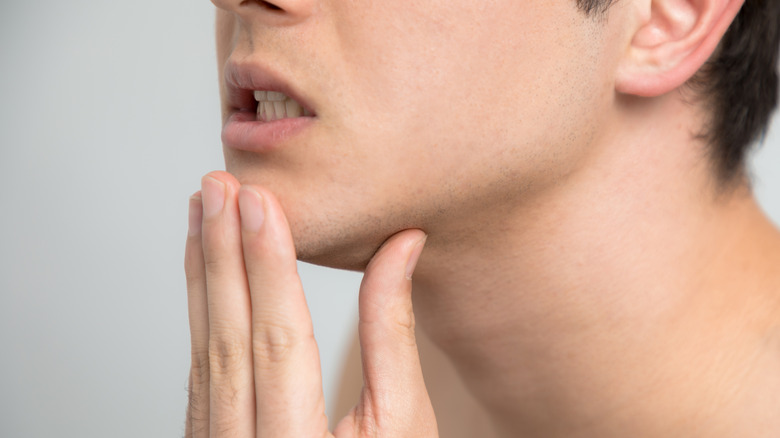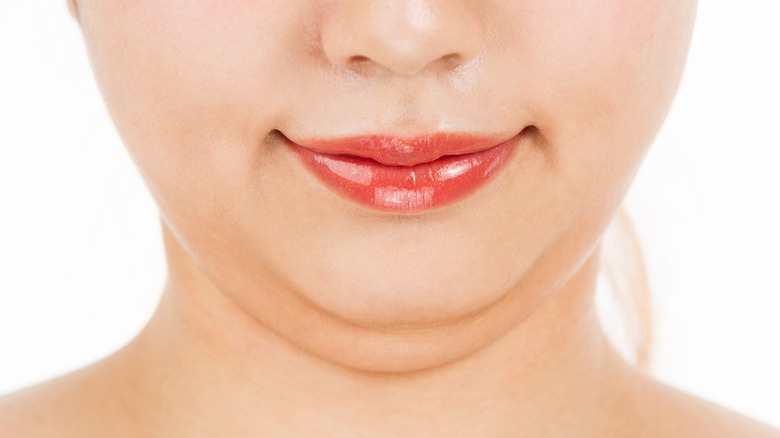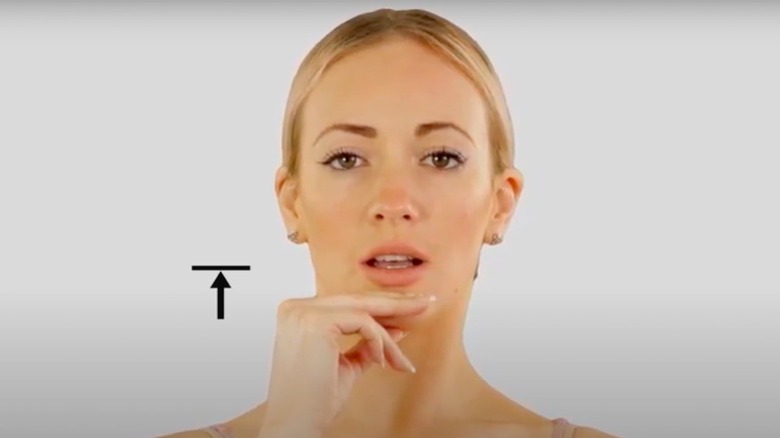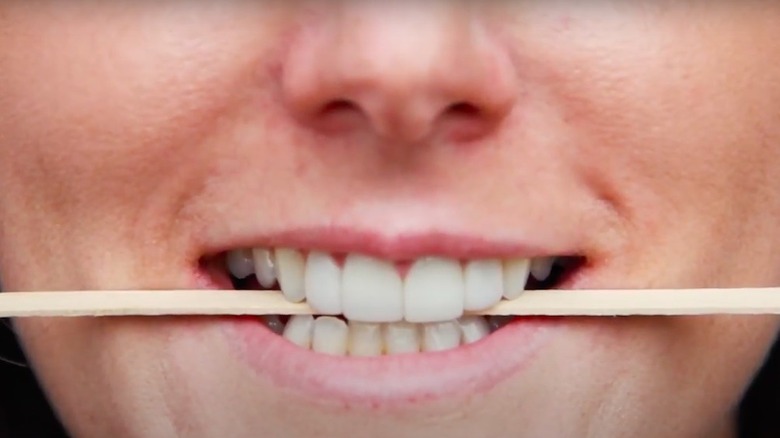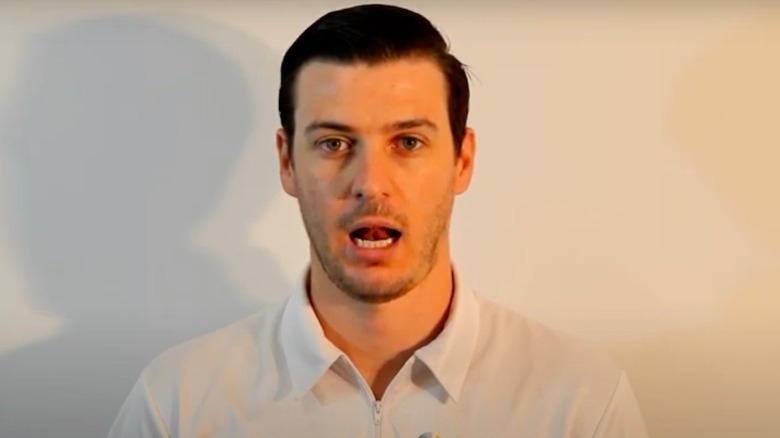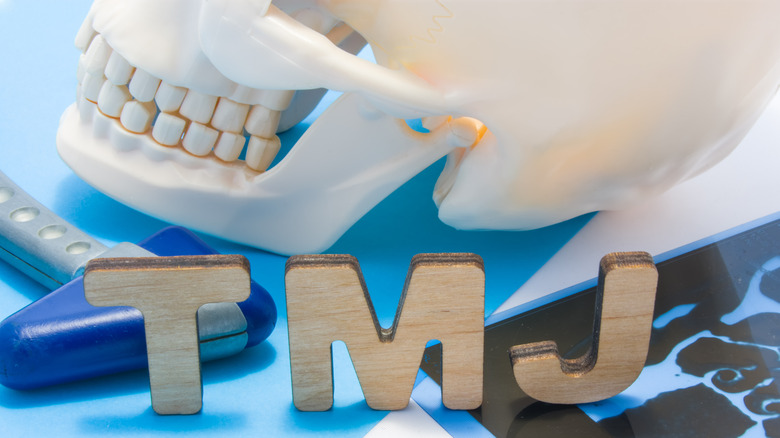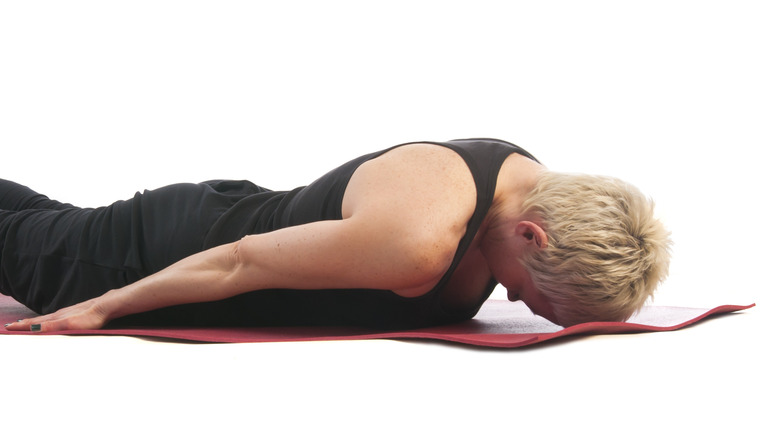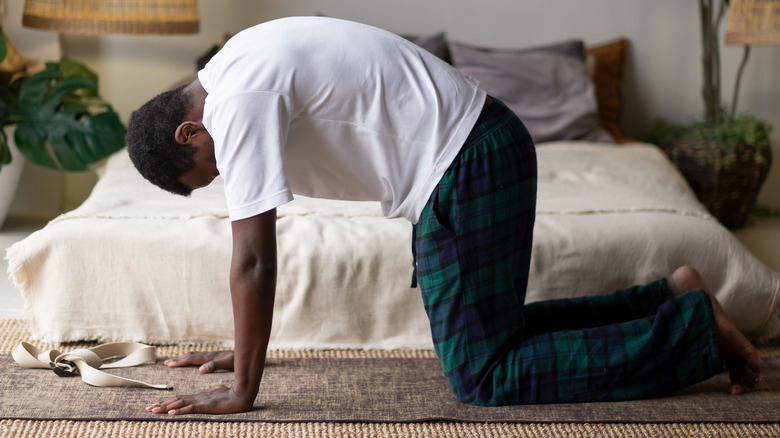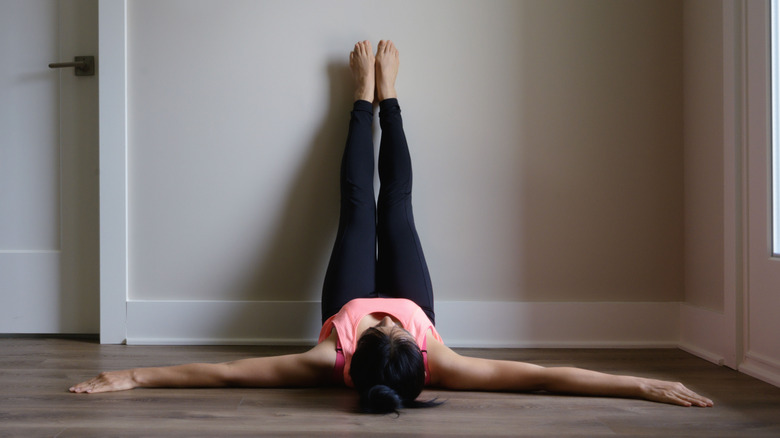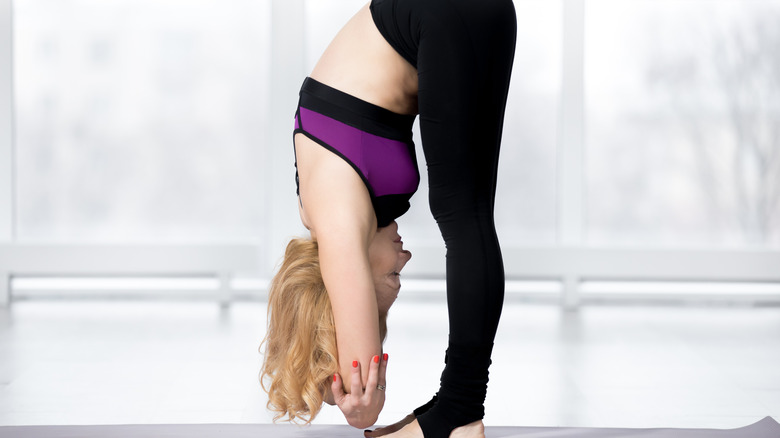Exercises To Help Relieve TMJ Pain
TMJ pain can be life-altering, negatively affecting many important aspects of life, including eating, sleeping, and your desire to do things with friends (via Headache & TMJ Specialists New Jersey). Without treatment, it can even lead to issues like insomnia, depression, and anxiety (via Cleveland Clinic). TMJ is short for temporomandibular joint, and you have two (via Mayo Clinic). These are the jaw joints in front of your ears that attach your lower jaw bones to your skull bones on the side of your head. Your TMJ functions as a hinge, helping your jaw move. Some people develop TMJ disorders, which are categorized by the following symptoms: soreness in the jaw or TMJ joint, pain in and around your ear or face, problems chewing or discomfort during chewing, jaw locking, and difficulty opening or closing your mouth.
Often it's quite challenging to pinpoint exactly what is causing TMJ pain. Possible causes include injuries, arthritis, some genetic factors, or an event that caused the jaw to move out of alignment. Chronic teeth grinding or clenching is also another possible risk factor. Sometimes TMJ issues are temporary and can be treated with self-care like exercises and other non-invasive measures. However, it's important to go see a doctor if you have constant pain in your jaw, or if you can't open or close your jaw all the way. A medical professional can help you identify potential causes and proper treatment.
Tips for managing pain
Some people may need surgery to address their TMJ issues, but many can make lifestyle changes and implement natural treatments to help relieve TMJ pain (via Cleveland Clinic). For example, you can try eating softer foods — like yogurt, smoothies, mashed potatoes, soup, scrambled eggs, and cooked foods — while avoiding harder, crunchy foods and chewing gum. Over-the-counter non-steroidal anti-inflammatory drugs (NSAIDs) like aspirin can help reduce pain and inflammation. You might also want to explore wearing a mouth or night guard, or corrective dental treatments.
Other simple but profound changes can also help, like intentionally resting your jaw throughout the day, maintaining good posture, sleeping well, lowering stress levels, and exercising your jaw with stretching, strengthening, and relaxation exercises (via Penn Medicine). In fact, a study published in the Journal of Dental Research found therapeutic exercises to be very effective in relieving pain and other symptoms associated with TMJ issues.
In addition, heat and cold can help decrease acute pain when coupled with exercises (via Cleveland Clinic). Try applying an ice pack to the source of your pain for about 10 minutes, then attempt a few exercises, and end with a warm washcloth application for five minutes . Make sure to check with your doctor before starting any exercise program to make sure the movements are right for you.
Goldfish exercise
One of the most common recommended exercises for addressing and relieving TMJ pain is called the goldfish exercise. Many medical professionals recommend this exercise to help strengthen the TMJ (via Roberson Dental Care). There are two versions of this movement: the partial opening and the full. To practice the partial opening, rest your tongue on the top (or roof) of your mouth and place one finger on the side of your jaw where your TMJ sits, right in front of your ear. Then, place the pointer or middle finger of your other hand on the front of your chin, right below your lips. Slowly lower your jaw halfway, using your finger to help direct and power the movement, then return to a closed-mouth position. A different variation of this movement is to place a finger on each TMJ joint instead of one finger on the chin.
The full version of the goldfish exercise involves lowering your jaw all the way down, then back up to closed. Whichever version you choose, repeat the movement six times for one set. It's generally recommended to do a total of six sets every day (via Healthline).
Chin tucks
Chin tucks are another popular exercise commonly recommended for helping with TMJ issues (via Spine-Health). This movement is done to help stretch the TMJ and jaw muscles, and it can also help strengthen the muscles in your neck, leading to proper head alignment and posture. This exercise involves — you guessed it — tucking your chin.
To practice this movement, you can begin seated or standing, whichever is more comfortable to you. Start to actively pull your shoulders down and back, while keeping your chest up (via Roberson Dental Care). Then, gently pull your chin straight backward, tucking your chin down and into your neck — essentially creating a "double chin." Try to hold this position for a count of three seconds, then relax to a neutral position. Attempt to breathe deeply and try not to hold your breath. Repeat this movement 10 times for a complete set (via Healthline).
Resisted opening and closing of the mouth
Resisted mouth movement can help strengthen the TMJ, as well as the muscles that help with chewing and eating (via Healthline). For this exercise, you will opening and close the mouth against light resistance. To begin practicing the resisted opening exercise, start by resting your thumb under your chin. Then, gradually begin opening your mouth, and softly apply resistance by pressing your thumb into your chin, working against the movement of your chin lowering. Remain in this position for three to six seconds, then slowly return your mouth to a closed position.
To practice the resisted closing exercise, start in a closed-mouth position. Using both hands, place the pointer fingers on the front of your chin (under your lips) and thumbs underneath your chin. Gently lower your jaw and open your mouth. Then, slowly try to close your mouth, softly squeezing your chin to apply gentle resistance to the movement (via Roberson Dental Care).
Side-to-side and forward jaw movement
To perform side-to-side and forward jaw movements, first find an object that is about a quarter-inch wide, like a tongue depressor, or a wooden spatula or popsicle stick (via Healthline). For the side-to-side movement, place the object in your mouth in between your front teeth. Then, keeping your teeth in contact with the object, steadily and softly move your jaw from side to side. As Healthline shows, you'll want to hold the object in your hand during this movement to help keep it in place. For the forward jaw movement, have the object rest in your mouth the same way, but move your bottom jaw forward until your bottom teeth are in front of your top teeth, and then draw it back again.
If these exercises become too easy for you over time, you can increase the thickness of the object you use. For example, you can stack two or more popsicle sticks on top of each other.
Tongue movement
According to Oxford University Hospital, tongue movement exercises will help strengthen the muscles that help move your jaw backward, and can help prevent the clicking noise that often comes with TMJ issues. It will also help relax the muscles that help close your mouth, move from side to side, as move forward and back. It's best to practice these exercises at a time of day when you typically feel calm, like maybe in the morning just upon waking or in the evening around bedtime.
Begin by sitting up straight. Close your mouth so that all of your teeth are touching, but your jaw is not clenching. Place the tip of your tongue on the roof of your mouth, just behind your two front teeth. Move your tongue tip to the back of your mouth, as far as you can go, while keeping your teeth touching. Keep your tongue here and slowly begin to open your jaw until you feel your tongue start to pull away from the roof of your mouth. Stop here and try to hold for five seconds, then close your mouth and rest. Repeat this movement for a total of five minutes. During the movement, you should hear no clicking — if you hear any noise, you may need to fix your jaw positioning and try again.
Intentional relaxation of jaw
Another exercise that can help relieve TMJ pain is working toward mindfully and purposefully relaxing your jaw and TMJ. Yoga Journal recommends attempting this practice while seated in meditation. Throughout the day and while we sleep, we may subconsciously and unintentionally clench our jaw or tense up our facial muscles, especially when we're experiencing stress or anxiety (via Tandara Dental Centre).
It's important to work on relaxing and releasing your jaw muscles every once and while. To practice this exercise, rest your tongue on the roof of your mouth, right behind your two front teeth. Slowly and slightly open your jaw, just a tiny bit, attempting to mindfully relax the muscles in your jaw. Try to allow the movement to be natural instead of feeling forced or robotic (via Roberson Dental Care). Try this exercise when you're feeling stressed out, maybe during your lunch break, before bed, or set a timer to practice it at a certain time every day.
Vamping pose
Many yoga poses can not only help with cultivating relaxation and mindfulness, but also support proper head alignment to help prevent jaw tension (via Yoga International). When first attempting vamping pose, begin in a seated position, gazing forward. Bend your right arm and place your right palm along the base of your skull, at the back of your neck where your neck and head connect. Lengthen the back of your neck a little bit. Slowly lift your left arm up and out to your side, pointing your fingertips away from your shoulder. Then, gradually turn your head to the left. Take three deep breaths, then rest. Repeat the same exercise on the other side. You can try to practice this exercise at different times throughout your day, or incorporate it into your yoga practice, if you have one.
If you are familiar with the yoga pose warrior II, you might try practicing this exercise during that pose, since the arm shape is slightly similar. This movement can help reduce the chances of your head and jaw protruding forward.
Downward facing cobra
To practice downward facing cobra, begin by lying on your stomach on a soft surface, like a yoga mat or squishy rug. Lift your head so that your forehead is floating just above the ground and gaze downward (via Yoga International). Note that this downward gaze is a variation on the traditional cobra pose, in which you typically lift your head up to gaze forward. In this variation of the pose, you will keep your chin tucked and focus on lengthening through your upper back to help strengthen the muscles in the back of your neck.
Bring your inner thighs together and place your arms along the sides of your torso. As you inhale, start to lift your chest away from the ground, continuing to look down and lengthen the back of your neck. When you naturally exhale, gently lower back down to the floor. Repeat this movement five times, moving slowly and steadily with control and intention.
Unlocking the jaw
This gentle exercise is like a slight self-massage on your jaw and TMJ (via Yoga International). To practice unlocking the jaw, start seated in a chair or on the floor, wherever you feel most comfortable. Make a fist with one hand, then gently place it on the side of your jaw. Slowly start to turn your head toward the fist, softly resisting the movement with your fist, but not pressing the fist into the jaw or moving your hand at all. This will help activate your sternocleidomastoid, an important muscle that controls the position of the head and jaw.
Then, you will begin to change the action so that your jaw is pressing into your fist — pause here for one or two deep breaths, then release and relax. Repeat the same movement on the other side. Try practicing this exercise with your mouth slightly ajar to help promote relaxation. Discontinue this exercise if your jaw makes a popping noise or feels irritated.
Neck strengthening exercise
Neck issues are commonly associated with TMJ pain — the neck and jaw are literally connected, after all. In fact, one scientific study found that 70% of patients with TMJ disorders also experience neck pain. Therefore, practicing exercises that help stretch or strengthen your neck muscles could help relieve TMJ issues.
One exercise that can help relieve jaw tension is a simple neck strengthener (via Yoga International). To practice, begin seated. Bend your elbows and interlace your fingers together. Then, place the palms of your hands against the back of your head, right at the base of your neck, where your neck connects with your skull. Softly and slowly press your head into your hands and pause here for three deep breaths. Then, keeping your hands and arms as they are, gradually turn your head to left, and again, press your head into your hands for three rounds of breath. Finally, turn your head the right and hold for three breaths, then relax.
Cat/cow pose
Cat/cow pose is a traditional yoga pose that can be adapted specifically to focus on relieving neck tension (via Healthline). To practice this variation, start on your hands and knees, with your palms face-down under your shoulders and your knees under your hips. As you inhale, look up and bring your belly toward the ground, making a "U" shape with your spine. You can look up at the sky or slightly lower your chin. As you exhale, look to the right, over your shoulder. Take a deep breath here, then return to center. On your next exhale, look to the left, over your shoulder. After one round of breath, return to center. Then, exhale to tuck your chin and arch your back, like a cat does. Stay here and allow your head to hang, moving it from side-to-side and forward and backward, if that feels comfortable. Repeat this flow for about one minute.
Legs-up-the-wall-pose
Legs-up-the-wall-pose is considered an inversion pose, which usually involves moving the head below the heart and hips — hence inverting the body from its typical standing position. In yoga, inversion poses can help both relax and strengthen muscles, as well as support circulation (via Healthline). This pose should help promote blood flow to the jaw and TMJ area (via Yoga Journal). To practice this pose, you will need a wall, and you might want a yoga mat or something soft to lie on (via Healthline). You also may want a pillow for under your head or to place in between your knees and the wall. To begin, start lying on your side, with your knees bent and your hips and feet close to the wall. Slowly turn to lie flat on your back and rest your feet up against the wall. Move your hips as close to the wall as feels comfortable. You can straighten your knees or keep them bent, whichever feels best. Rest your arms wherever you would like. You can stay in this shape for as long as you'd like — up to 20 minutes — then gently push yourself away from the wall with your feet, and roll back to one side or rest on your back for a moment. Take your time coming back up to a seated position.
Standing forward bend pose
Standing forward bend is another traditional yoga pose that involves a chin tuck and inversion, which will help bring blood flow down to your head, including to your TMJ (via Wanderlust). To practice this pose, begin standing with your feet hip width distance apart (via Healthline). Extend through the upper body and begin folding forward at the hips, maintaining a small bend in the knees. You can rest your hands on your legs, yoga blocks, the floor, or a chair. Tuck your chin in to your chest as you try to relax the muscles around your neck, allowing your head to hang. Try to relax your jaw. If it feels okay, you can shake your head as if you're saying "yes" or "no," or move it in small circles, to help release tension in the neck and shoulders. Attempt to stay in this position for up to one minute, breathing deeply. As you inhale, slowly come back up to standing, bringing your head up last.



